An Experimental Investigation on the Progressive Failure of Unsaturated Granular Slopes
Abstract
:1. Foreword
2. Materials and Methods
2.1. Equipment
2.2. Technical Characteristics of the Fibers
2.3. Soil Properties
3. Experimental Results
3.1. RP2 Experiment
3.2. RP3 Experiment
- -
- The progressive downslope movement, with points 4 and 5 moving first and more than the others;
- -
- The shear strain acceleration, which more or less takes place when the rainwater reaches the base of the layer (RP2 experiment, Figure 5);
- -
- The ductile soil behavior, which attains a cumulated shear strain of 3.5 × 10−1 and a strain rate of roughly 10−4 s−1 in the upper zone (RP2 experiment, Figure 13a,b).
4. Conclusions
Author Contributions
Funding
Acknowledgments
Conflicts of Interest
References
- Bjerrum, L. Progressive failure in slopes in overconsolidated plastic clay and shales. ASCE J. Soil Mech. Found. Div. 1967, 93, 139–190. [Google Scholar]
- Leroueil, S.; Locat, A.; Eberhardt, E.; Kovacevic, N. Progressive Failure in Natural and Engineered Slopes. In Proceedings of the 11th International Symposium on Landslides, Banff, AB, Canada, 3–8 June 2012; CRC press: Banff, AB, Canada, 2012; Volume 1, pp. 31–46. [Google Scholar]
- Burland, J.B.; Longworth, T.I.; Moore, J.F.A. A study of ground movement and progressive failure caused by a deep excavation in Oxford clay. Géotechnique 1977, 27, 557–591. [Google Scholar] [CrossRef]
- Cooper, M.R.; Bromhead, E.N.; Petley, D.J.; Grant, D.I. The Selborne cutting stability experiment. Géotechnique 1998, 48, 83–101. [Google Scholar] [CrossRef]
- Alonso, E.E.; Gens, A. Aznalcóllar dam failure. Part 1: Field observations and material properties. Géotechnique 2006, 56, 165–183. [Google Scholar] [Green Version]
- Urciuoli, G.; Picarelli, L.; Leroueil, S. Local soil failure before general slope failure. Geotech. Geol. Eng. 2007, 25, 103–122. [Google Scholar] [CrossRef]
- Yerro, A.; Alonso, E.E.; Pinyol, N.M. Modeling large deformation problems in unsaturated soils. In Proceedings of the 3rd European Conference on Unsaturated Soils, Frontiers on Unsaturated Soils, Paris, France, 12–14 September 2016. [Google Scholar]
- Cascini, L.; Guida, D.; Nocera, N.; Romanzi, G.; Sorbino, G. A Preliminary Model for the Landslides of May 1998 in Campania Region. In Proceedings of the Second International Symposium on Hard Soils–Soft Rocks, Naples, Italy, 12–14 October 1998; Evangelista, A., Picarelli, L., Eds.; Balkema: Naples, Italy, 2000; Volume 3, pp. 1623–1649. [Google Scholar]
- Fiorillo, F.; Guadagno, F.M.; Aquino, S.; De Blasio, S. The December 1999 Cervinara landslides: Further debris flows in the pyroclastic deposits of Campania (southern Italy). Bull. Eng. Geol. Environ. 2001, 60, 171–184. [Google Scholar] [CrossRef]
- Olivares, L.; Damiano, E. Post-failure mechanics of landslides: A laboratory investigation of flowslides in pyroclastic soils. ASCE J. Geotech. Geoenviron. Eng. 2007, 133, 51–62. [Google Scholar] [CrossRef]
- Zhu, Z.-W.; Liu, D.-Y.; Yuan, Q.-Y.; Liu, B.; Liu, J.-C. A novel distributed optic fiber transducer for landslides monitoring. Opt. Lasers Eng. 2011, 49, 1019–1024. [Google Scholar] [CrossRef]
- Schenato, L. A review of distributed fibre optic sensors for geo-hydrological applications. Appl. Sci. 2017, 7, 896. [Google Scholar] [CrossRef]
- Coscetta, A.; Minardo, A.; Olivares, L.; Mirabile, M.; Longo, M.; Damiano, M.; Zeni, L. Wind turbine blade monitoring with brillouin-based Fiber-Optic Sensors. J. Sens. 2017, 9175342. [Google Scholar] [CrossRef]
- Damiano, E.; Mercogliano, P.; Netti, N.; Olivares, L. A “simulation chain” to define a multidisciplinary Decision Support System for landslide risk management in pyroclastic soils. Nat. Hazards Earth Syst. Sci. 2012, 12, 989–1008. [Google Scholar] [CrossRef]
- Intrieri, E.; Gigli, G.; Mugnai, F.; Fanti, R.; Casagli, N. Design and implementation of a landslide early warning system. Eng. Geol. 2012, 147, 124–136. [Google Scholar] [CrossRef] [Green Version]
- Olivares, L.; Damiano, E.; Mercogliano, P.; Picarelli, L.; Netti, N.; Schiano, P.; Savastano, V.; Cotroneo, F.; Manzi, M. A simulation chain for early prediction of rainfall-induced landslides. Landslides 2014, 11, 765–777. [Google Scholar] [CrossRef]
- Olivares, L.; Damiano, E.; Greco, R.; Zeni, L.; Picarelli, L.; Minardo, A.; Guida, A.; Bernini, R. An instrumented flume to investigate the mechanics of rainfall-induced landslides in unsaturated granular soils. Geotech. Test. J. 2009, 32, 108–118. [Google Scholar]
- Damiano, E.; Avolio, B.; Minardo, A.; Olivares, L.; Picarelli, L.; Zeni, L. A laboratory study on the use of optical fibers for early detection of pre-failure slope movements in shallow granular soil deposits. Geotech. Test. J. 2017, 40, 529–541. [Google Scholar] [CrossRef]
- Damiano, E.; Olivares, L.; Picarelli, L. Steep-slope monitoring in unsaturated pyroclastic soils. Eng. Geol. 2012, 137, 1–12. [Google Scholar] [CrossRef]
- Olivares, L.; Picarelli, L. Shallow flowslides triggered by intense rainfalls on natural slopes covered by loose unsaturated pyroclastic soils. Géotechnique 2003, 53, 283–288. [Google Scholar] [CrossRef]
- Hunter, G.; Fell, R. Mechanics of failure of soil slopes leading to “rapid” failure. In Proceedings of the International Conference on Fast Slope Movements: Prediction and Prevention for Risk Mitigation, Napoli, Italy, 11–13 May 2003; pp. 283–290. [Google Scholar]
- Damiano, E.; Greco, R.; Guida, A.; Olivares, L.; Picarelli, L. Investigation on rainfall infiltration into layered shallow covers in pyroclastic soils and its effect on slope stability. Eng. Geol. 2017, 220, 208–218. [Google Scholar] [CrossRef]
- Tatsuoka, F. Compaction Characteristics and Physical Properties of Compacted Soils Controlled by the Degree of Saturation. In Proceedings of the Sixth International Symposium on Deformation Characteristics of Geomaterials. IS-Buenos Aires, Buenos Aires, Argentina, 15–18 November 2015. [Google Scholar]
- Scarcella, G.E.; Giusti, I.; Giusti, S.; Lo Presti, D.C.; Squeglia, N. Strength and Permeability Parameters of Compacted, Partially Saturated Silty and Sandy Soils. Riv. Ital. Geotec. 2018, 2, 58–69. [Google Scholar]
- Damiano, E.; Olivares, L. The role of infiltration processes in steep slopes stability of pyroclastic granular soils: laboratory and numerical investigation. Nat. Hazards 2010, 52, 329–350. [Google Scholar] [CrossRef]
- Picarelli, L.; Evangelista, A.; Rolandi, G.; Paone, A.; Nicotera, M.V.; Olivares, L.; Scotto di Santolo, A.; Lampitiello, S.; Rolandi, M. Mechanical Properties of Pyroclastic Soils in Campania Region. In Proceedings of the 2nd International Workshop on Characterisation and Engineering Properties of Natural Soils, Singapore, 29 November–1 December 2006; Volume 4, pp. 2331–2384. [Google Scholar]
- Olivares, L.; Picarelli, L. Modelling of flowslides behaviour for risk mitigation. In Proceedings of the 6th ICPMG ’06, International Conference on Physical Modelling in Geotechnics, Ng, Hong Kong, China, 2–4 August 2006; Volume 1, pp. 99–113. [Google Scholar]
- Olivares, L. Static liquefaction: An hypothesis for explaining transition from slide to flow in pyroclastic soils. In Proceedings of the Conference TC-11 ISSMGE Transition from Slide to Flow: Mechanisms and Remedial Measure, Trabzon, Turkey, 25–26 August 2001. [Google Scholar]
- Olivares, L.; Damiano, E.; Netti, N.; De Cristofaro, M. Geotechnical Properties of Two Pyroclastic Deposits Involved in Catastrophic Flowslides for Implementation in Early Warning Systems. Geosciences 2019, 9, 24. [Google Scholar] [CrossRef]
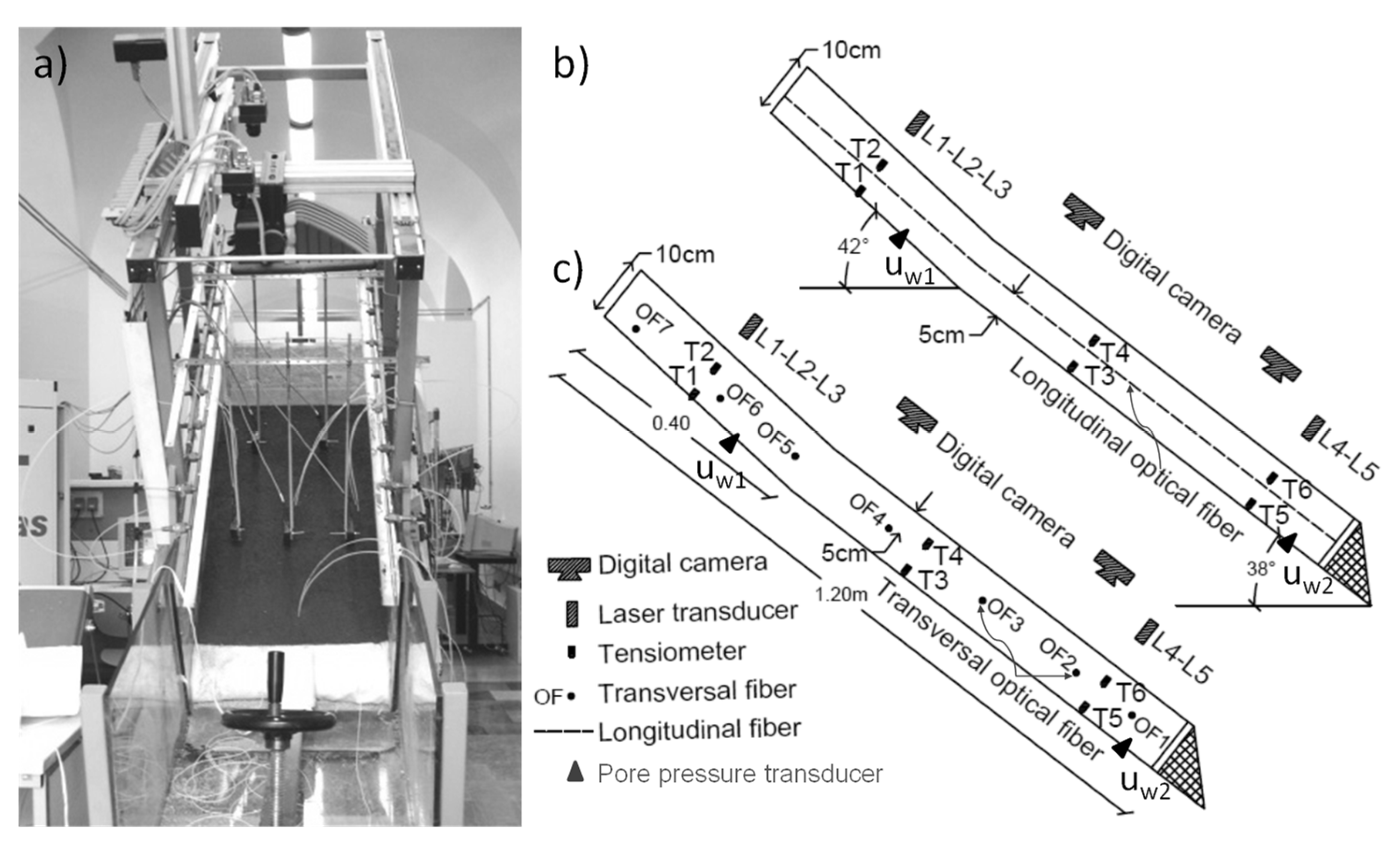
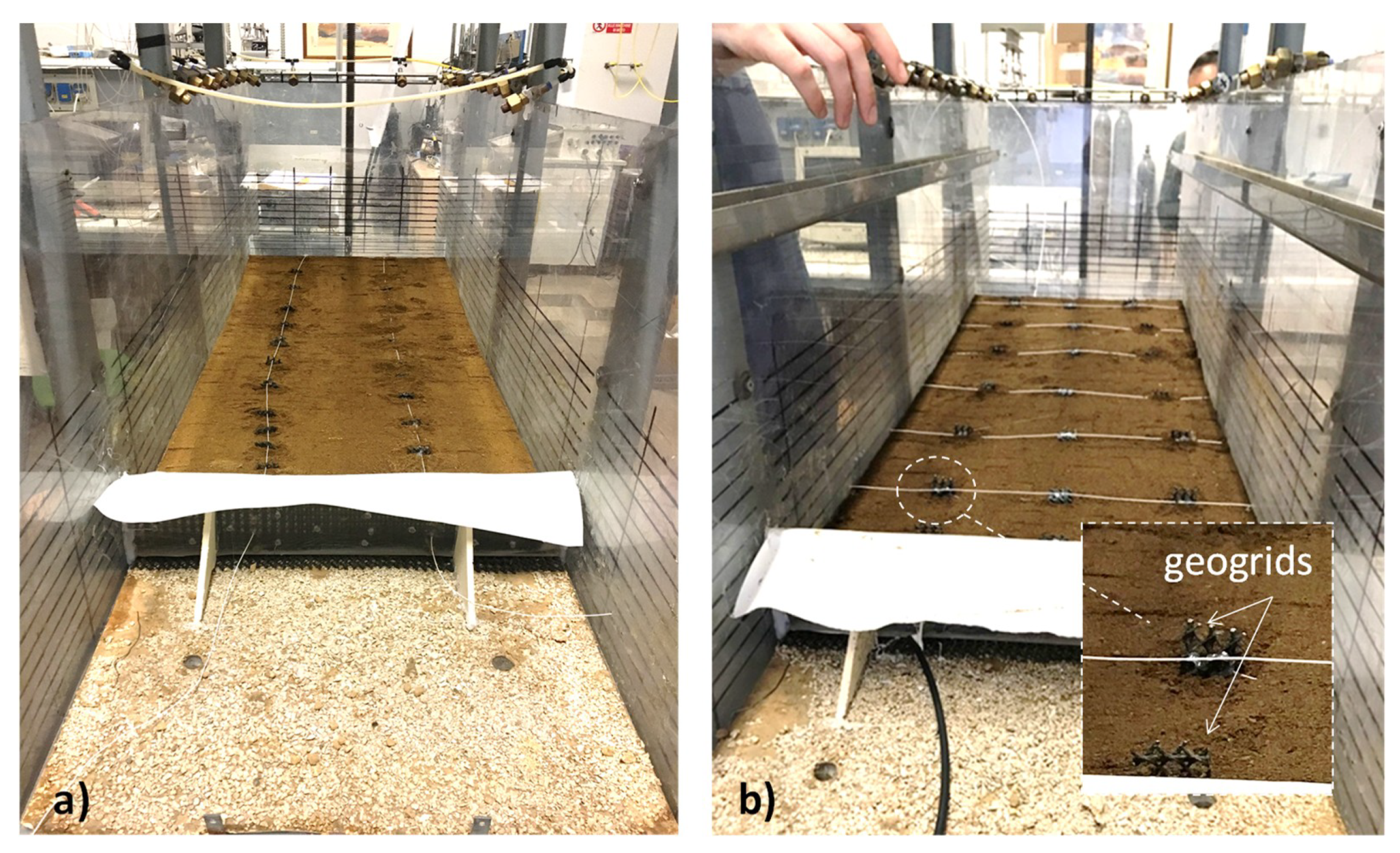
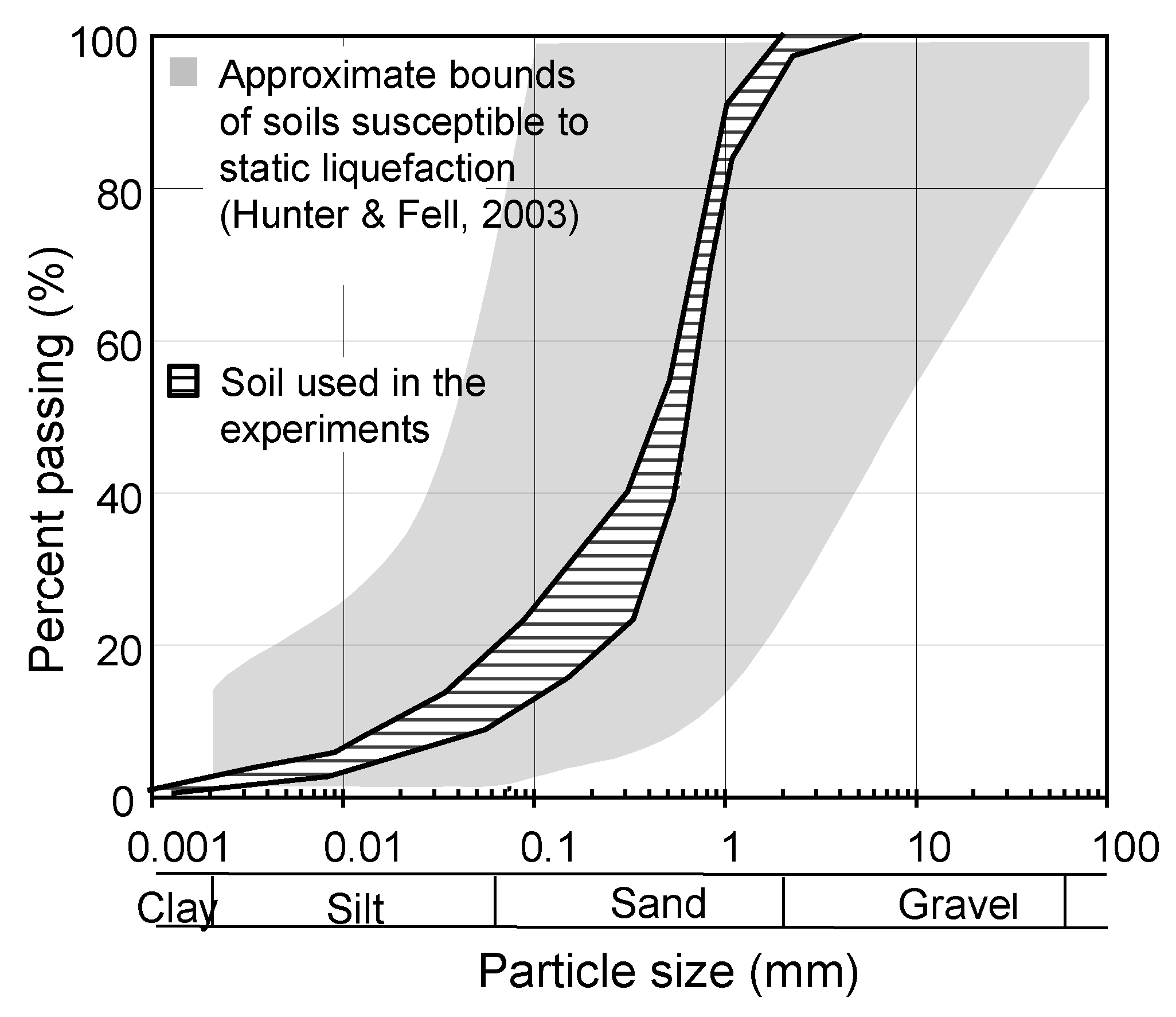
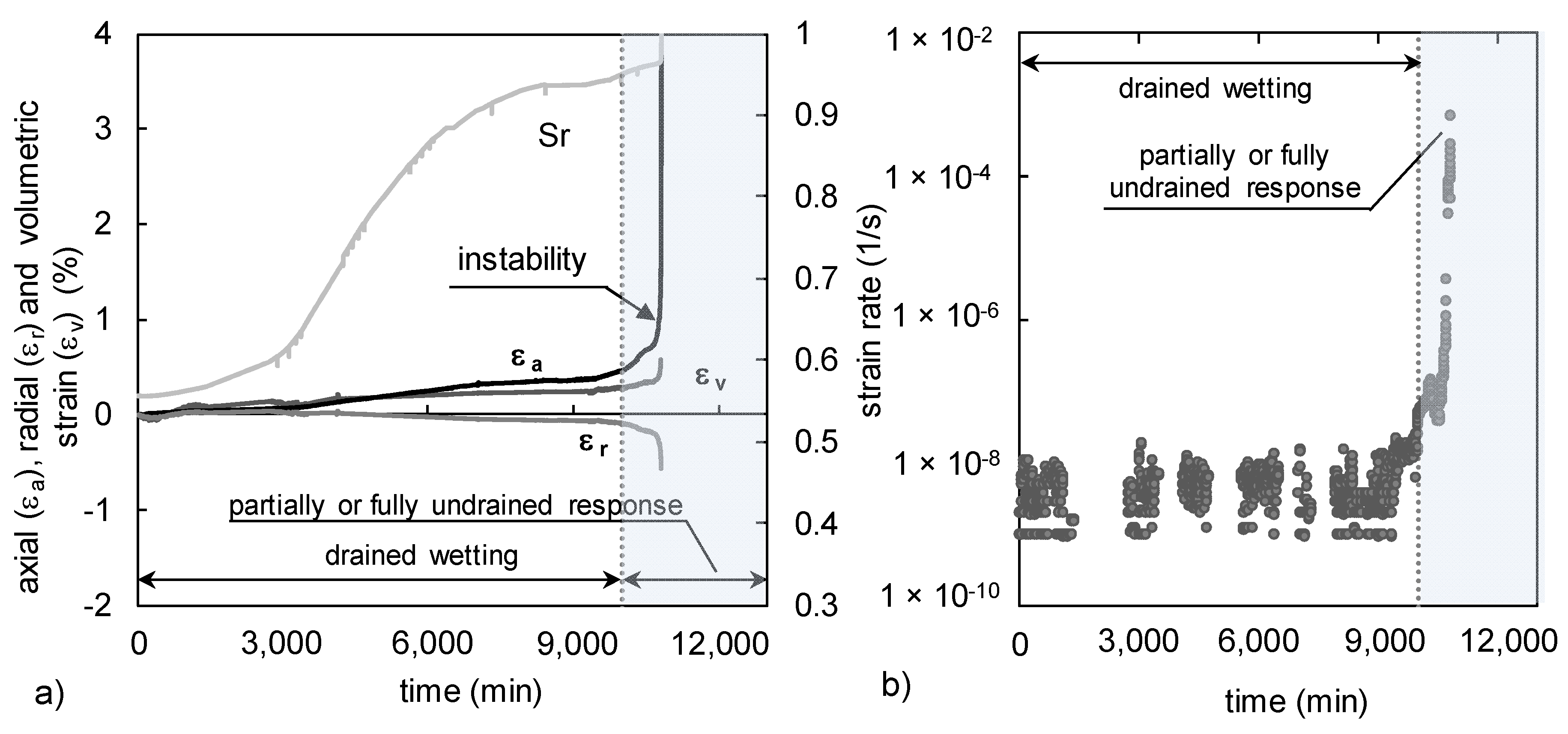
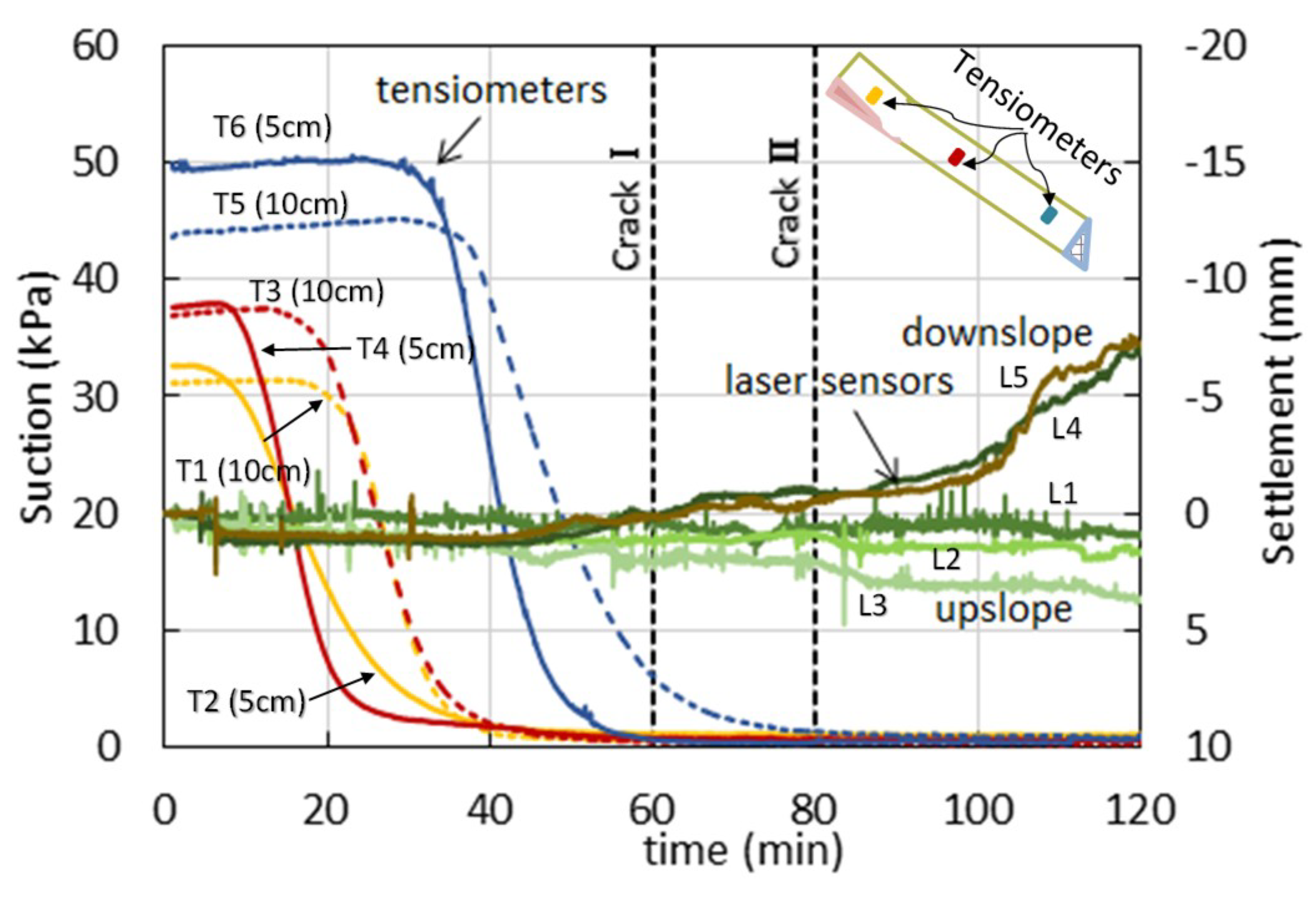


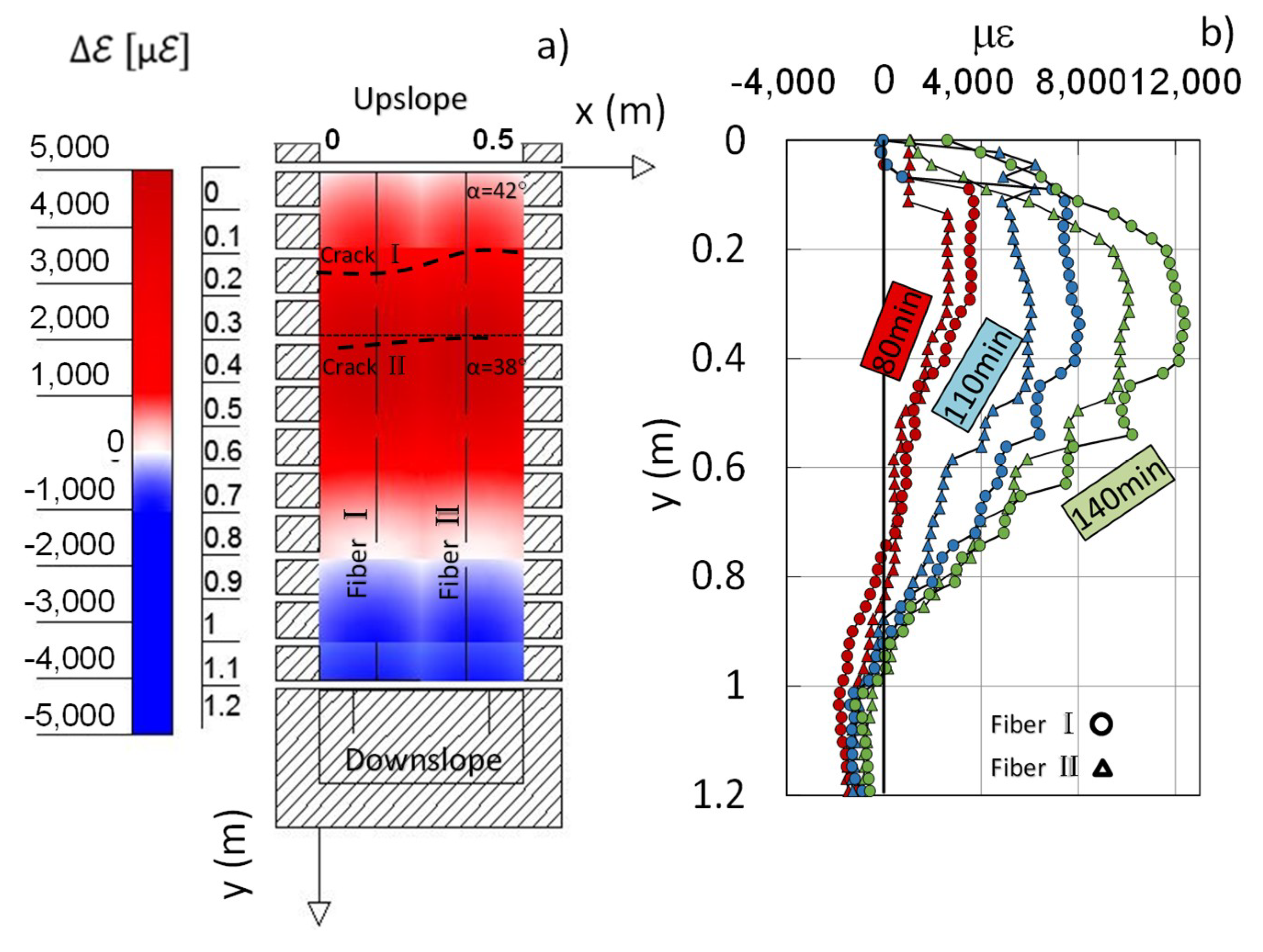
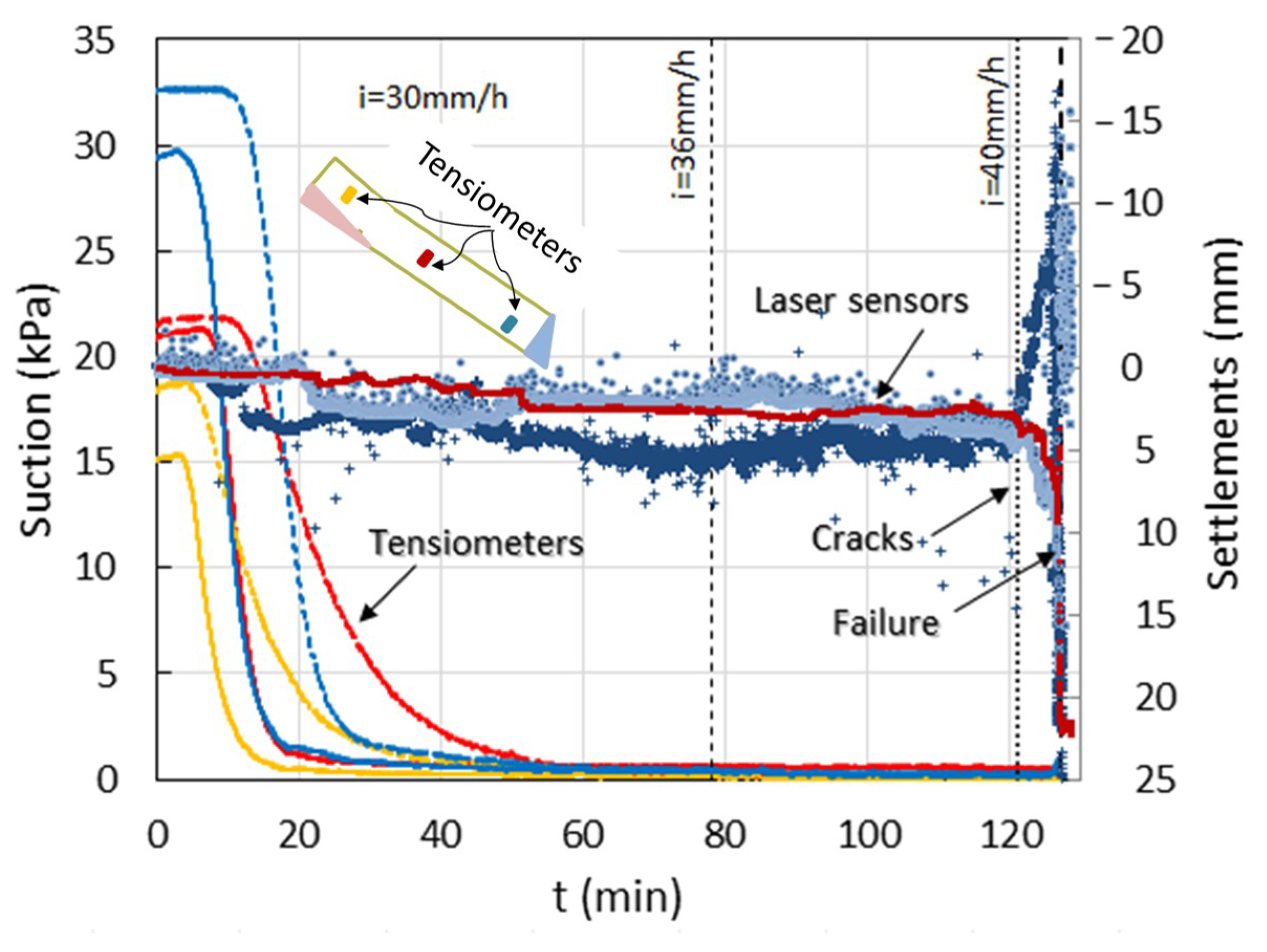



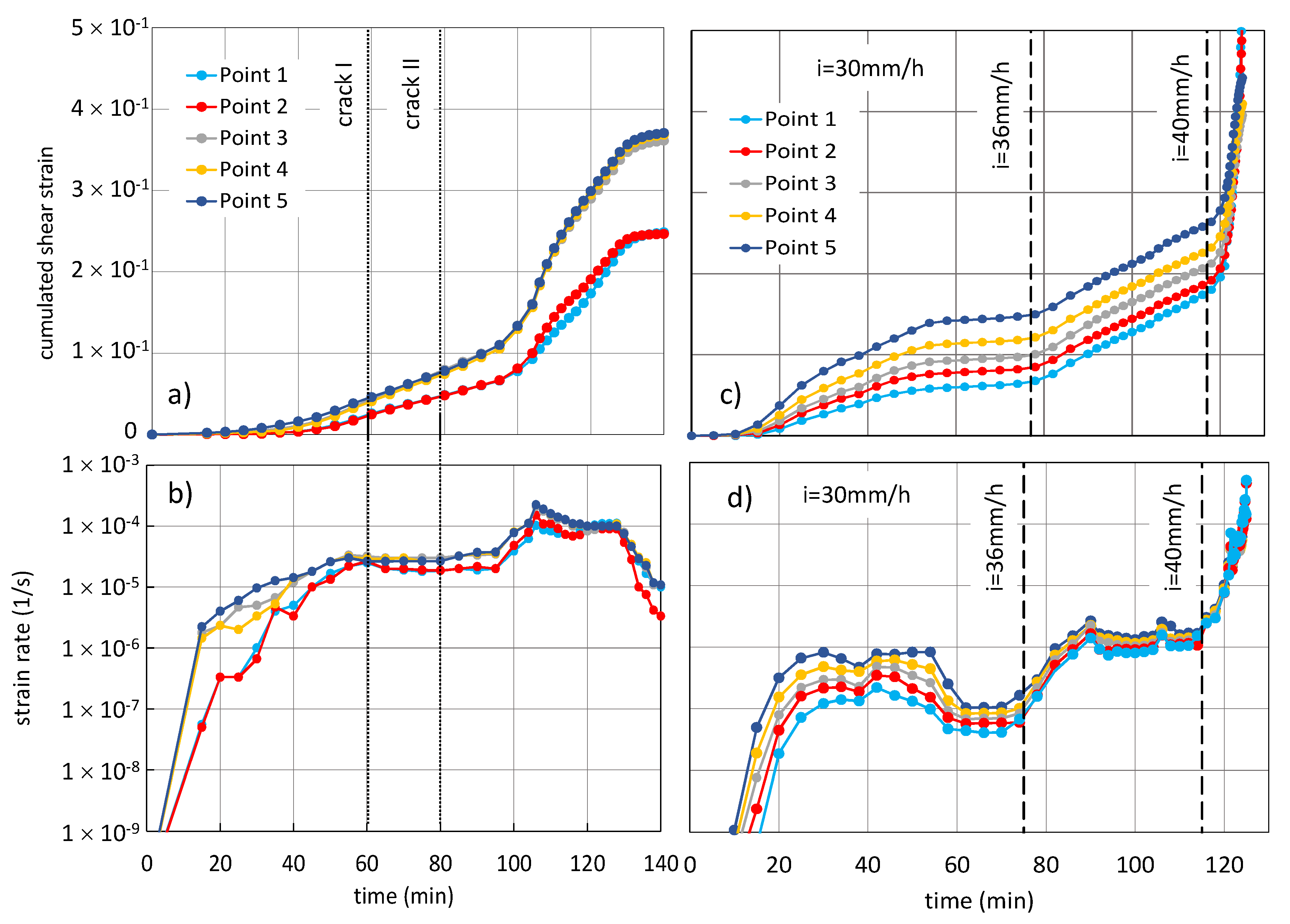
| Test. | Slope Length (m) | Slope Width (m) | Slope Thickness (m) | Slope Angle (°) | w (%) | n (%) | Sr (%) | i (mm/h) | Δt (min) |
|---|---|---|---|---|---|---|---|---|---|
| RP2 | 1.2 | 0.50 | 0.10 | 38–42 | 40–43 | 72 | 41–43 | 30 | 158 |
| RP3 | 1.2 | 0.50 | 0.10 | 38–42 | 39–42 | 70 | 44–47 | 30–36–40 | 126 |
© 2019 by the authors. Licensee MDPI, Basel, Switzerland. This article is an open access article distributed under the terms and conditions of the Creative Commons Attribution (CC BY) license (http://creativecommons.org/licenses/by/4.0/).
Share and Cite
Darban, R.; Damiano, E.; Minardo, A.; Olivares, L.; Picarelli, L.; Zeni, L. An Experimental Investigation on the Progressive Failure of Unsaturated Granular Slopes. Geosciences 2019, 9, 63. https://doi.org/10.3390/geosciences9020063
Darban R, Damiano E, Minardo A, Olivares L, Picarelli L, Zeni L. An Experimental Investigation on the Progressive Failure of Unsaturated Granular Slopes. Geosciences. 2019; 9(2):63. https://doi.org/10.3390/geosciences9020063
Chicago/Turabian StyleDarban, Reza, Emilia Damiano, Aldo Minardo, Lucio Olivares, Luciano Picarelli, and Luigi Zeni. 2019. "An Experimental Investigation on the Progressive Failure of Unsaturated Granular Slopes" Geosciences 9, no. 2: 63. https://doi.org/10.3390/geosciences9020063
APA StyleDarban, R., Damiano, E., Minardo, A., Olivares, L., Picarelli, L., & Zeni, L. (2019). An Experimental Investigation on the Progressive Failure of Unsaturated Granular Slopes. Geosciences, 9(2), 63. https://doi.org/10.3390/geosciences9020063









